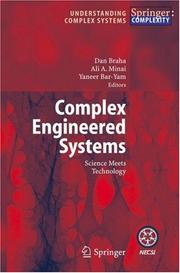| Listing 1 - 2 of 2 |
Sort by
|

ISBN: 9780387717968 038771796X 9786611043766 1281043761 0387717978 Year: 2007 Volume: 110 Publisher: New York : Springer,
Abstract | Keywords | Export | Availability | Bookmark
 Loading...
Loading...Choose an application
- Reference Manager
- EndNote
- RefWorks (Direct export to RefWorks)
In building reliability into a system, engineers must address a number of practical needs that will enable them to quantify and compare reliability in engineered systems. (1) One is to be able to compare the reliability of one system to another system. (2) Another practical need is to compare alternate system designs for the purpose of engineering a particular optimal system. The practical, standardized, technical tool for characterizing reliability in systems is system signatures which was created in 1985 and since has developed into a powerful tool for qualifying reliability. It is used in all physical structures and stochastic systems where reliability is an important consideration (e.g., automobiles, bridges, electronic networks, airplanes, etc.) Since the introduction of system signatures in Francisco Samaniego’s 1985 paper, the properties of this technical concept have been examined, tested and proven in a wide variety of systems applications. Based on the practical and research success in building reliability into systems with system signatures, this is the first book treatment of the approach. It is, therefore, the purpose of this book to provide guidance on how reliability problems might be structured, modeled and solved. Over the past ten years the broad applicability of system signatures has become apparent and the tool’s utility in coherent systems and communications networks firmly established. The book compared actual system lifetimes where the tool has been and has not been used. These comparisons—which have been done over the years—demonstrate the practical, feasible and fruitful use of the tool in building reliable systems. Finally, new results and future directions for system signatures are also explored. .
Reliability (Engineering) --- Engineering systems --- Fiabilité --- Systèmes d'ingénierie --- Engineering systems. --- Maintainability (Engineering). --- Reliability (Engineering) -- Statistical methods. --- Reliability (Engineering). --- Distribution (Probability theory) --- Industrial & Management Engineering --- Technology - General --- Materials Science --- Chemical & Materials Engineering --- Mechanical Engineering --- Engineering & Applied Sciences --- Statistical methods. --- Fiabilité --- Systèmes d'ingénierie --- EPUB-LIV-FT LIVINGEN SPRINGER-B --- Engineering. --- Operations research. --- Decision making. --- System theory. --- Probabilities. --- Statistics. --- Quality control. --- Reliability. --- Industrial safety. --- Quality Control, Reliability, Safety and Risk. --- Statistics for Engineering, Physics, Computer Science, Chemistry and Earth Sciences. --- Probability Theory and Stochastic Processes. --- Operation Research/Decision Theory. --- Systems Theory, Control. --- Mathematical statistics --- Engineering

ISBN: 9783540328315 3540328319 9786610949304 1280949309 3540328343 Year: 2006 Publisher: Berlin, Heidelberg : Springer,
Abstract | Keywords | Export | Availability | Bookmark
 Loading...
Loading...Choose an application
- Reference Manager
- EndNote
- RefWorks (Direct export to RefWorks)
Every time that we take money out of an ATM, surf the internet or simply turn on a light switch, we enjoy the benefits of complex engineered systems. Systems like power grids and global communication networks are so ubiquitous in our daily lives that we usually take them for granted, only noticing them when they break down. But how do such amazing technologies and infrastructures come to be what they are? How are these systems designed? How do distributed networks work? How are they made to respond rapidly in 'real time'? And as the demands that we place on these systems become increasingly complex, are traditional systems-engineering practices still relevant? This volume examines the difficulties that arise in creating highly complex engineered systems and new approaches that are being adopted. Topics addressed range from the formal representation and classification of distributed networked systems to revolutionary engineering practices inspired by biological evolution. By bringing together the latest research in Complex Engineered Systems, this book sheds light on the current state and future course of this emerging field.
Engineering systems. --- Technological complexity. --- Systèmes d'ingénierie --- Complexité technologique --- Engineering systems --- Technological complexity --- Mechanical Engineering --- Engineering & Applied Sciences --- Industrial & Management Engineering --- Complexity, Technological --- Physics. --- Artificial intelligence. --- Applied mathematics. --- Engineering mathematics. --- Statistical physics. --- Dynamical systems. --- Industrial engineering. --- Production engineering. --- Electrical engineering. --- Biomedical engineering. --- Statistical Physics, Dynamical Systems and Complexity. --- Industrial and Production Engineering. --- Electrical Engineering. --- Biomedical Engineering. --- Applications of Mathematics. --- Artificial Intelligence (incl. Robotics). --- Clinical engineering --- Medical engineering --- Bioengineering --- Biophysics --- Engineering --- Medicine --- Electric engineering --- Manufacturing engineering --- Process engineering --- Industrial engineering --- Mechanical engineering --- Management engineering --- Simplification in industry --- Value analysis (Cost control) --- Dynamical systems --- Kinetics --- Mathematics --- Mechanics, Analytic --- Force and energy --- Mechanics --- Physics --- Statics --- Mathematical statistics --- Engineering analysis --- Mathematical analysis --- AI (Artificial intelligence) --- Artificial thinking --- Electronic brains --- Intellectronics --- Intelligence, Artificial --- Intelligent machines --- Machine intelligence --- Thinking, Artificial --- Bionics --- Cognitive science --- Digital computer simulation --- Electronic data processing --- Logic machines --- Machine theory --- Self-organizing systems --- Simulation methods --- Fifth generation computers --- Neural computers --- Natural philosophy --- Philosophy, Natural --- Physical sciences --- Dynamics --- Statistical methods --- Anthropology --- Industries, Primitive --- Computer engineering. --- Mathematics. --- Complex Systems. --- Biomedical Engineering and Bioengineering. --- Artificial Intelligence. --- Math --- Science --- Computers --- Design and construction --- Technology
| Listing 1 - 2 of 2 |
Sort by
|

 Search
Search Feedback
Feedback About
About Help
Help News
News